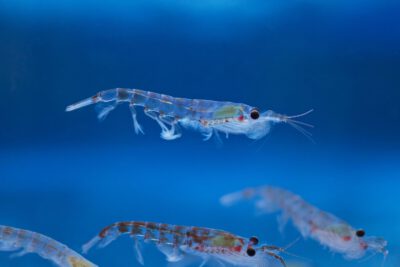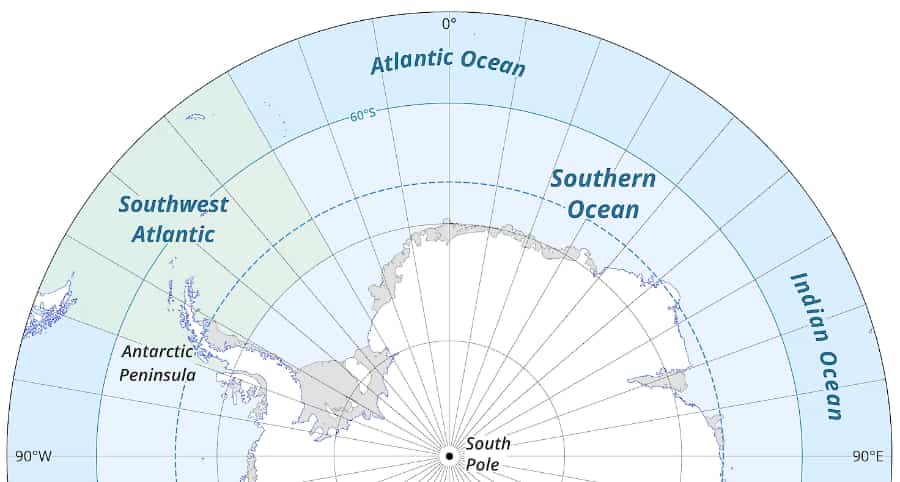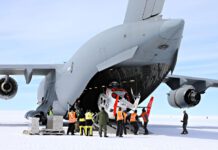
Some populations of Antarctic krill are shifting south, closer to Antarctica, as ocean warming and sea-ice changes alter their habitat.
Scientists fear the movement of krill will have a negative impact on predators like whales, seals and penguins, and alter broader ocean ecosystem functions.
The finding, published in Nature Reviews Earth & Environment today, comes after an international scientific team, led by Australian Antarctic Program krill scientist Dr So Kawaguchi, reviewed decades of published Antarctic krill research.
The team found krill populations and habitats have shifted south in the ‘Southwest Atlantic sector‘ of the Southern Ocean, off the Antarctic Peninsula (see map below).
They also observed a decline in the density of krill in the sector, north of 60°S – an area that supports a major krill fishery.
Dr Kawaguchi said the changes could have significant flow-on effects for krill behaviour and physiology, predator interactions, and krill’s important role in removing carbon from surface waters to the deep ocean.
“Analysis of a krill dataset collected over more than 50 years, showed habitat contraction in the Southwest Atlantic sector was associated with a reduced occurrence of krill swarms in the northern extent of the habitat, and a decline in krill density,” Dr Kawaguchi said.
“There is also a major disruption in the characteristics of krill populations in the Southwest Atlantic sector, driven by rapid climate change that has resulted in a decrease in the annual sea-ice season by three months. This has reduced critical habitat for adult and juvenile krill.“
Shifting swarms
Krill surveys between 1926 and 2004 showed the Southwest Atlantic sector contained about 27 per cent of the circumpolar krill population, making it the “centre” of the Antarctic krill population.
Dr Kawaguchi said recent research showed the concentration of krill in the sector, relative to other sectors, has declined over the past 25 years.
“Krill density in Southwest Atlantic was 8.5 times higher than that of other sectors 100 years ago, but in recent years it is only 2.2 times higher,” Dr Kawaguchi said.
“This could be due to a redistribution of krill to other sectors and a more even spread around Antarctica.”
He said changes in the amount of krill in an area affects the number, size and/or density of krill swarms, and could significantly impact the Southern Ocean ecosystem.
“Large changes in krill density in space and/or time has major implications for their food, their predators and for carbon and nutrient cycling,” he said.
Large krill swarms are thought to influence the local environment by turbulent mixing and redistributing iron (important for phytoplankton growth) and other nutrients, between surface and deep waters.

They also enhance the movement of carbon from the surface to the deep ocean by eating phytoplankton – which remove carbon dioxide from the air – and producing carbon-rich faeces and moults that sink to the seafloor.
Changing food web
Dr Kawaguchi said changes in the density of krill, and their southward shift, could be an advantage to other organisms that compete for phytoplankton, such as salps and copepods, leading to an increase in these species.
However, reduced krill abundance will have a negative impact on whales, seals and penguins.
Penguins, for example, have established breeding colonies in close proximity to areas with historically high numbers of krill.
“Antarctic penguins need reliable access to krill close to their breeding sites to feed their chicks, so if they have to forage further away, it could negatively impact chick survival,” Dr Kawaguchi said.
“Reduced prey availability, due to changes in krill distribution, will also affect the reproduction and survival of whales and other predators.”
read more www.antarctica.gov.au/news/2023/antarctic-krill-head-south/
Department of Climate Change, Energy, the Environment and Water – Australian Antarctic Division
www.antarctica.gov.au








